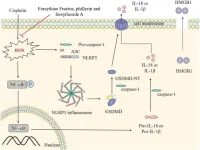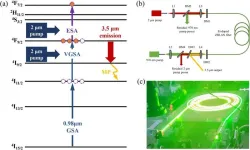(Press-News.org) VANCOUVER, Wash. – Even in the precipitation-heavy Pacific Northwest, more frequent heatwaves are threatening a key source of water supply.
A Washington State University study that intended to look at snow melting under a single, extreme event, the 2021 “heat dome,” instead revealed an alarming, longer-term rising trend of successive heatwaves melting snowpack earlier in the year.
The findings have implications for many areas worldwide that are dependent on snow-capped mountains to provide summer water since heatwaves have been on the rise globally.
“Short-term events like heatwaves have had an under-appreciated impact on accelerating snow melt, and cumulatively, they can amplify each other,” said Luke Reyes, a doctoral student in WSU’s School of the Environment, and lead author of the study published in npj Climate and Atmospheric Science.
Heat domes, rare events that occur when the atmosphere traps hot ocean air, caused record temperatures nearing 122 degrees Fahrenheit across the Pacific Northwest in late June 2021. Yet, the researchers found that by the time the dome arrived, a lot of the region’s snowpack had already melted.
Their analysis of high-resolution snowpack and temperature data revealed that high-elevation snow had started melting during a series of heatwaves in April, May and early June -- when temperatures were 7.2 to 12.6 degrees Fahrenheit above normal.
Even more concerning, when the researchers looked back at temperature records spanning from 1940 to 2021, they saw that these springtime heatwaves have doubled in frequency, intensity or both since the mid-1990s.
“The data suggests that we don't necessarily need to be worried about a very rare event like the heat dome, but that heat waves are becoming far more prevalent and are more likely to be driving a lot of snowpack loss in the future,” said co-author Marc Kramer, a WSU associate professor of environmental chemistry.
The effect of short-term heatwaves on snowpack has been understudied because historically researchers looked at snowpack levels on April 1 and average monthly temperatures to estimate climate change impacts on snowpack loss. Those averages might show single-digit temperature increases but obscure the impact of heat spikes that may last just a couple days.
Also, for many years, mountainous snowpack was thought to be resilient to short-term high temperatures in spring because it remained sufficiently cold at high elevations. The WSU study revealed that this buffering capacity appears to have diminished in the face of more frequent and intense heatwaves.
In 2021, the combined result of heatwaves and the heat dome meant the snowpack melted about three weeks earlier than usual, with most snow cover gone by late June. Normally, snowmelt provides the Pacific Northwest with water well into August.
This extreme early melting occurred even though 2021 was a La Niña year, a global weather phenomenon that typically means a deeper snowpack. In fact, Pacific Northwest snowpack that spring was 135% of normal for the higher-elevation snow zone and its 18-year record examined by the study. By the end of June, though, that was gone.
This rapid melt does not bode well for the coming year, 2024, which is expected to have drier weather brought by El Niño.
“We have a coming El Niño year and next year, and there may be some amplification effects,” said Kramer. “If we have less snow to begin with, the snowpack is going to be all that much more vulnerable to these heat anomalies earlier in the season.”
The study is part of the Kramer lab’s broader research into heat wave impacts on ecosystems and agriculture. This research is supported by a grant from the U.S. Department of Agriculture’s National Institute of Food and Agriculture.
END
Pacific Northwest snowpack endangered by increasing spring heatwaves
2023-12-13
ELSE PRESS RELEASES FROM THIS DATE:
Inbiomotion and The Scientific Group sign an exclusive distribution agreement of MAF Test® for the Sub-Saharan Africa
2023-12-13
Barcelona and Johannesburg, December 13th, 2023
The Scientific Group, a leader in the IVD industry, and Inbiomotion, a company commercializing its proprietary MAF Test® for identifying high risk early-stage breast cancer patients have signed an agreement to start marketing MAF Test® in Sub-Saharan Africa. The MAF Test® predicts the prognosis of breast cancer patients and helps oncologists to identify those patients who may be able to prevent recurrence and benefit from adjuvant treatment with bisphosphonates, which are commonly used to treat osteoporosis. The test also identifies those patients whose prognosis would worsen if treated with bisphosphonates.
Breast ...
Adults with cognitive disabilities are more likely to have worse experiences with health care system
2023-12-13
People with cognitive disabilities – like autism, attention deficit and memory loss – are less satisfied with their health care than those in the general population, according to a study published by a Rutgers researcher.
The study, published in Disability and Health Journal, examined how a national sample of adults experience the care they receive and the factors that contribute to their experiences.
“People with cognitive disabilities were less likely than people without ...
A sugar analysis could reveal different types of cancer
2023-12-13
In the future, a little saliva may be enough to detect an incipient cancer. Researchers at the University of Gothenburg have developed an effective way to interpret the changes in sugar molecules that occur in cancer cells.
Glycans are a type of sugar molecule structures that is linked to the proteins in our cells. The structure of the glycan determines the function of the protein. It has been known for a while that changes in glycan structure can indicate inflammation or disease in the body. Now, researchers at the University of Gothenburg have developed a way to distinguish different ...
Natural gas is actually migrating under permafrost, and could see methane emissions skyrocket if it escapes
2023-12-13
Beneath Svalbard’s permafrost, millions of cubic meters of methane are trapped — and scientists have now learned that it can migrate beneath the cold seal of the permafrost and escape. A large-scale escape could create a cycle of warming that would send methane emissions skyrocketing: warming thaws the permafrost, causing more gas to escape, allowing more permafrost to thaw and more gas to be released. Because Svalbard’s geological and glacial history is very similar to the rest of the Arctic region, these migrating deposits of methane are likely ...
New tool helps gauge trust in government
2023-12-13
People are less likely to adopt new health policies if they don't have faith in their government, and a new tool from University of Waterloo researchers aims to fix that.
The tool – designed by a team based in Waterloo's School of Public Health Sciences - aids lawmakers in how trustworthy they may appear to the public and could help improve the uptake of public health policies by informing their design and communication.
Policymakers can use the tool to measure citizens' trust in government and inform the design and communication of public health initiatives in ways that build confidence across members of ...
Potential of forsythiae fructus in mitigating chemotherapy-induced gastrointestinal inflammation and nausea
2023-12-13
Chemotherapy-induced nausea and vomiting (CINV) are among the most prevalent and distressing side effects faced by patients undergoing antineoplastic treatments. This condition can lead to complications such as dehydration, metabolic imbalances, anorexia and weakened physical stamina. Notably, highly emetic drugs such as cisplatin are notorious for causing severe nausea and vomiting in approximately 90% of patients. Therefore, enhancing the management of CINV is of utmost importance.
Chemotherapy-induced inflammation in the gastrointestinal tract is considered ...
Minor wavelength optimization causes large power improvement
2023-12-13
Recent attention has been devoted to develop high-power mid-infrared fiber lasers due to their applications in free-space communication, atmospheric remote sensing, and high-resolution spectroscopy. With the “0.98 μm+2 μm” dual-wavelength pumping scheme, mid-infrared laser emission at 3.5 μm can be obtained from Er-doped fluoride fiber laser. However, an intrinsic excited state absorption (ESA) also exhibits absorption at 2 μm pump wavelength, which reduces the pump quantum efficiency. Even worse, the ESA starts from the upper ...
ASH 2023 Tip Sheet from Sylvester Comprehensive Cancer Center
2023-12-13
Many physician-scientists and other researchers from Sylvester Comprehensive Cancer Center at the University of Miami Miller School of Medicine will be making oral or poster presentations or participating in panel discussions at the American Society of Hematology’s 2023 annual meeting in San Diego, Dec. 9-12.
Below is an EMBARGOED summary, highlighting several presentations involving Sylvester physicians and other staff members. For more information on any of these story ideas or to arrange an interview, please email Sandy Van, sandy.van@miami.edu, or call/text 808.206.4576.
Please note that all information is strictly embargoed until the date and ...
New study identifies the best areas for rewilding European bison
2023-12-13
At the end of the last ice age, large herds of bison roamed across Europe. But by 1927, the European bison became extinct in the wild, with only about 60 individuals remaining in captivity. Scientists have long debated the exact causes of the grazers’ near extinction, and how much humans were to blame.
A new study combines fossil evidence, ancient DNA, and modeling to disentangle the threats that forced the European bison’s population decline. Rapid environmental change and hunting by humans were the main drivers, according to the study, published today in the journal Proceedings of the Royal Society B: Biological Sciences.
Since the near-extinction of the European ...
People who see climate change as a health threat show more interest in cancer screening
2023-12-13
Brigham researchers’ findings support developing public health interventions that incorporate components of environmental health literacy alongside cancer screening efforts.
The world’s climate crisis has wide ranging implications for human health. But how do our perceptions about climate change influence our intentions when it comes to personal health? A new study by investigators from Brigham and Women’s Hospital, a founding member of the Mass General Brigham healthcare ...




